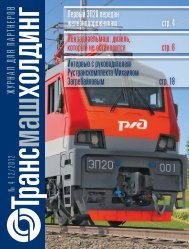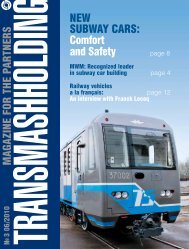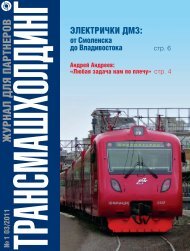Download
Download
Download
You also want an ePaper? Increase the reach of your titles
YUMPU automatically turns print PDFs into web optimized ePapers that Google loves.
COOPERATION<br />
plant. But it is not enough just to work<br />
out the documentation for the car — it<br />
is required to ensure the engineering of<br />
the new components as well. Thanks to<br />
the suppliers they immediately joined<br />
the work with a very tight schedule.<br />
The companies КМТ (St. Petersburg),<br />
Transkon (Tver), Gamem (Istra), Krosna-<br />
Electra (Moscow), PVS (Penza), Continent<br />
(St. Petersburg) and others took the most<br />
proactive stance in the process.<br />
By August 2008 the majority of the<br />
documentation was submitted to start<br />
the manufacturing. The car was built on<br />
December 29, 2008. Seven months after<br />
the decision on the commencement of<br />
the works.<br />
Let’s discuss in detail the technical<br />
features of the double-deck car of the<br />
model 61-4465.<br />
The passenger capacity of the car is<br />
64 people which is 1.8 times bigger than<br />
that of a single-deck car (36).<br />
The passenger places of the car are<br />
arranged on two levels. On the first and<br />
second levels each there are 8 fourseater<br />
passenger compartments. The<br />
compartment includes all the familiar<br />
elements of the single-deck car but the<br />
sleeping places are not transformable,<br />
they are ordinary: the transformable ones<br />
proved to be overly heavy and did not fit<br />
the permissible axle load of 18 tonnes.<br />
The subordinate areas of the car are<br />
located on the intermediate, “medium”<br />
deck with its floor arranged on the level<br />
of the high platform. The levels are<br />
connected with a staircase. The lowered<br />
level of the first deck allows the car to<br />
negotiate into the clearance adopted at<br />
the Russian railroads and without any<br />
restrictions to pass the bridges, tunnels<br />
and other artificial facilities.<br />
At the working end of the car on the<br />
intermediate level there is a subordinate<br />
division and the compartment for the<br />
conductors. In the non-working end of<br />
the car there are three lavatory rooms<br />
and a vertical lavatory spill tank. Such<br />
layout is caused by the fact that under<br />
the car, which is a traditional location<br />
of the collection tank and other rigging,<br />
there is no space due to the lowered<br />
down lower deck.<br />
The car is designed for operation as<br />
part of regular make-up trains. Therefore<br />
its configuration includes a centralized<br />
energy supply system through a high<br />
voltage static converter located in the<br />
under-roof area of the working end of the<br />
car. It applies slack-free coupling devices<br />
and hermetic inter-car gangways that<br />
allowed to refuse from the non-working<br />
vestibule.<br />
Ventilation, air-conditioning and air<br />
heating units are installed in the car. The<br />
heating system is pneumatic with the<br />
application of high-voltage air-heaters<br />
mounted at the exit of the ventilation<br />
units.<br />
Another outstanding innovation is an<br />
aerosol fire extinguishing system applied<br />
in the Russian passenger car building for<br />
the first time. The capacity of the water<br />
tanks and the lavatory collection tank is<br />
sufficient for the running of the car<br />
without changing for 48 hours. The car<br />
body has smooth side walls made of<br />
corrosion-resistant steel. The side<br />
entrance doors are automatic of reclinesliding<br />
type, the front doors are automatic<br />
of folding double-swing type. The car<br />
bogies are bolterless type — model 68-<br />
4095 with the disc brakes and antiskid<br />
system produced by a foreign company<br />
with the installed brake cylinders of the<br />
increased diameter.<br />
The representatives of JSC RZD studied<br />
the double-deck prototype and its<br />
structural features and were positive<br />
that they built a car in Tver that would<br />
allow to significantly boost the economic<br />
efficiency of the passenger traffic on the<br />
loaded passenger flow routes.<br />
In April 2009 the Tver Carriage<br />
Works was visited by Mr. Vladimir<br />
Yakunin, the President of the JSC RZD,<br />
and Mr Vladimir Putin, Prime-Minister<br />
of the Russian Federation, who expressed<br />
a high opinion on the innovated product<br />
designed in Tver. And in September<br />
2009 the car was shown to the public<br />
on the Second International Rail Road<br />
Exhibition EXPO-1520. During 2009 the<br />
car was undergoing preliminary test as per<br />
Double-deck car interior<br />
the expanded program at the base of the<br />
Tver Institute of Rail Car building. They<br />
performed the weighing of the car by each<br />
wheel, static tests of the body strength,<br />
thermal performance tests, sanitaryhygienic,<br />
electrical tests as well as the<br />
crash tests. On the updated model of the<br />
car built in 2007 they conducted fire live<br />
tests f to check the fire safety features of<br />
the car. As per the results of the tests the<br />
design documentation was updated to the<br />
effect of the improvement of the technical<br />
and consumer characteristics of the car.<br />
To ensure the formation of completeset<br />
trains two more models have to be<br />
added to the compartment car — the<br />
double-deck HQ car and a double-deck<br />
restaurant car as well as a modification<br />
of the compartment car in the “SV”<br />
variant. For today all the engineering<br />
documentation is available, which has to<br />
be implemented in metal and plastic.<br />
№2 03/2010 19









